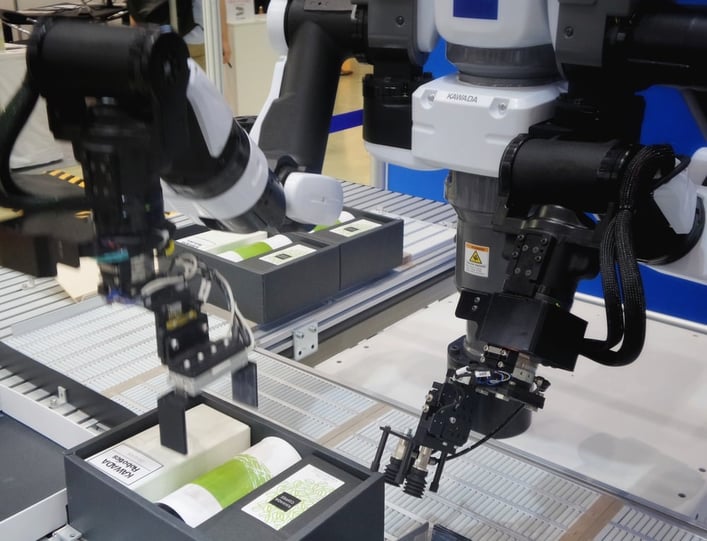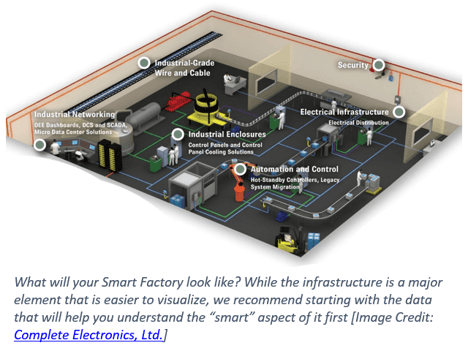
Photo by Franck V. on Unsplash
“Industry 4.0” is a term now in common use generally to describe the “fourth industrial revolution”, a term that it is used interchangeably with. But what does it mean, on a high level and specifically for what impact it might have on your business?
To get us all on the same page, let’s first go back to “Industry 1.0” and be clear about the other distinct eras of industrial revolution:

“Industry 4.0” = “Fourth Industrial Revolution”
The term was actually coined in 2011 in Germany (which was “Industrie 4.0”). Also going by “I4.0”, “I4”, “M4”, or even “Work 4.0”, it came from a high-tech strategy project in the German government that was promoting the computerization of manufacturing.
To use the direct Wikipedia definition, it is “the trend towards automation and data exchange in manufacturing technologies and processes which include cyber-physical systems (CPS), the internet of things (IoT), industrial internet of things (IIOT), cloud computing, cognitive computing and artificial intelligence.”
That is a mouthful. But it might be easier to understand it by visualizing the “Smart Factory” where all of these things would ideally come together, and envision a manufacturing process that involves machines augmented with wireless connectivity and sensors, connected to a system with visibility of the entire production line while making decisions on its own and interacting with humans where relevant and necessary. It implies a “smart” level of automation enabling flexible mass-customization that is automated by the machines interacting with customers, market data from the cloud, managers provided inputs, suppliers, etc.
For those looking to jump in and start at a manageable level, “Becoming a Smart Factory” would make a good starter definition.
The Smart Factory Visualized
According to IBM, the average factory creates about 1 Terabyte of data EVERY DAY, yet uses makes use of less than 1% of it in analytics.
Assuming you are about “average”, where would you start to incorporate more of your data into your production processes?
Let’s start with the four main Design Processes of Industry 4.0 as a way to break it down:
Interconnection – Defined as “The ability of machines, devices, sensors, and people to connect and communicate with each other via the Internet of Things (IoT) or the Internet of People (IoP)”
Information transparency - provides operators with vast amounts of useful information needed to make appropriate decisions, allowing operators to collect data and information from all points in the process to aid functionality and identify key areas that can benefit from innovation and improvement.
Technical assistance – is both the ability of assistance systems to support humans by visualizing aggregated information comprehensively to make informed decisions and solve urgent problems and the ability of cyber physical systems to physically support humans by conducting a range of tasks where human coworkers don’t add value or is unsafe.
 Decentralized decisions - Where cyber physical systems make decisions on their own and perform tasks as autonomously as possible with the exception of exceptions, interferences, or conflicting goals, which are delegated to a higher level.
Decentralized decisions - Where cyber physical systems make decisions on their own and perform tasks as autonomously as possible with the exception of exceptions, interferences, or conflicting goals, which are delegated to a higher level.
If you are already underutilizing data, you may want to start by looking at what you have before investing in the tools that geometrically expand the amount of data you collect. If Data Analytics is not a skill set you have internally, then get some outside help to inventory your current data assets and then look at what you might be able to learn from it.
Common types of overlooked data that could contribute to a short-term improvement in your processes would include:
- Error or reject data that would point to quality control issues on your line or a supplier’s.
- Customer support data – i.e. what percent of new products generate a support ticket?
- Sales data – broken down by product, regions, industries, etc. and even by returns.
- Supplier data – is anyone causing production delays through quality or distribution errors? Are the costs competitive enough?
Getting Started Down the Path
 The point is – what are you doing now, and what could you do next that involves additional data you may already have? This is how you start, by using what you have and then looking at it to help you decide the next step. Think of it as a basic report. You get the initial report to tell you some basic facts about the process, but then the data you see leads to some questions you might have, which leads to more details in the report, or perhaps another new report. Over time, your understanding of the data gets more sophisticated as you have more questions. Evolving your manufacturing processes can evolve the same way.
The point is – what are you doing now, and what could you do next that involves additional data you may already have? This is how you start, by using what you have and then looking at it to help you decide the next step. Think of it as a basic report. You get the initial report to tell you some basic facts about the process, but then the data you see leads to some questions you might have, which leads to more details in the report, or perhaps another new report. Over time, your understanding of the data gets more sophisticated as you have more questions. Evolving your manufacturing processes can evolve the same way.
You’ll read a lot of articles that will focus on the “digital” aspect of Industry 4.0. While it is about the digitalization of your processes, there is a good chance that you already have a LOT of your business in the digital space already – a cloud account, your Auto ID technology, your ERP or WMS systems, and more. Build some analytics muscle to generate some ACTIONABLE data points – not only to improve your current processes, but to point you to where your next set of investments should be in your modernization efforts. Wherever you start, it’s important to have the actionable data on hand to base your initial assumptions on with which you can create a reasonably sound vision and roadmap.










